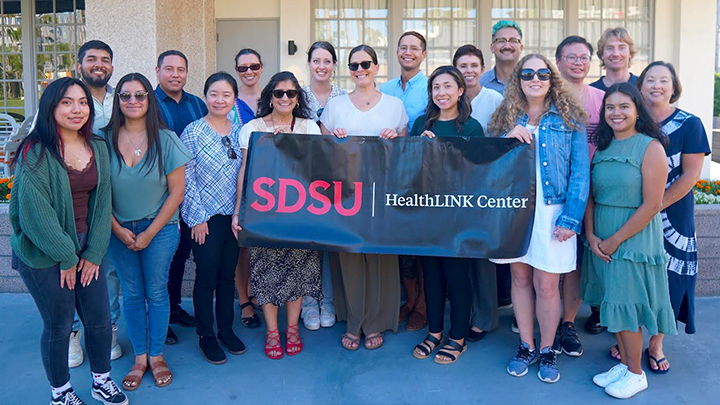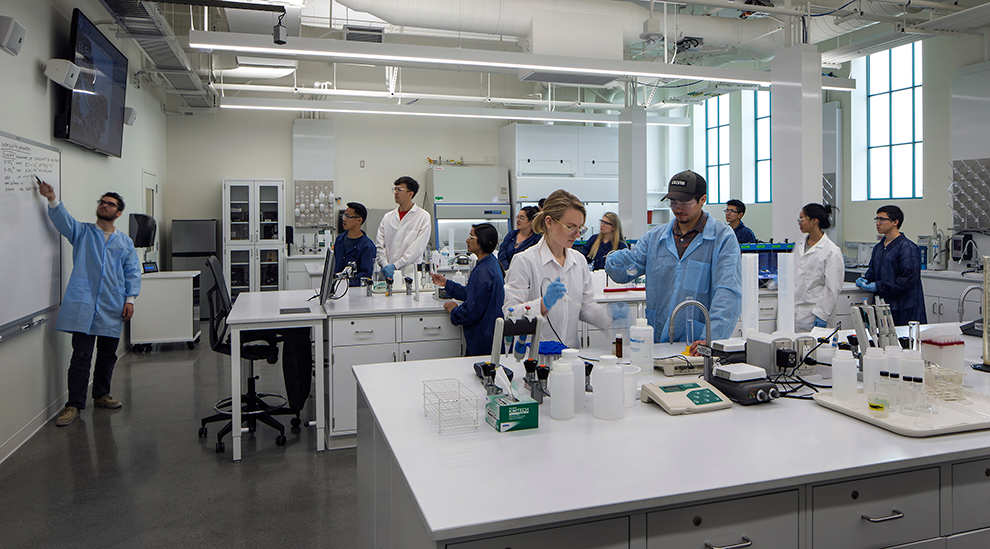SDSU HealthLINK Center secures $22M NIH award
The award will fund the HealthLINK Center through March 2029, supporting three research projects that address the well-being of the region’s most underserved populations.

A $22 million grant to the San Diego State University HealthLINK Center from the National Institutes of Health (NIH) will renew support for five more years of operation, including the implementation of three research projects and several pilot projects aimed at addressing health disparities among residents of San Diego and Imperial counties.
Announced Aug. 19, the award will help SDSU and SDSU Imperial Valley continue their commitment to critical health research and services designed to address the well-being of the region’s most underserved populations.
The center was created in 2018 thanks in large part to a $19.9 million award which was the largest NIH grant ever awarded to SDSU and the second-largest grant in university history behind only the $30 million federal grant SDSU received in 2014 to establish a campus in the republic of Georgia.
“This significant grant further demonstrates the growing expertise and competitiveness of our faculty in securing prestigious awards,” said SDSU President Adela de la Torre.
“To secure the founding grant in 2018 from the public-funding leader in biomedical research represented a belief in SDSU’s expertise and capabilities,” de la Torre said. “Securing this second, even larger NIH grant underscores that the HealthLINK Center has delivered significant benefit to these underserved communities in the six years since.”
The founding grant was part of an effort by the NIH’s National Institute on Minority Health and Health Disparities (NIMHD) to support research at minority-serving institutions, like SDSU. The university is a federally designated Hispanic-Serving Institution and an Asian American Native American and Pacific Islander-Serving Institution, and 38% of students are underrepresented minorities.
“I am grateful that NIMHD has agreed to continue investing in the SDSU HealthLINK Center, and the phenomenal research that our investigators are conducting, including with community partners,” said Guadalupe X. “Suchi” Ayala, who co-directs the center alongside Kristen Wells.
“Five years ago, I am not sure any of us knew what we were getting into joining the Research Centers at Minority Institutions’ network of institutions. Fast forward six years and with an infrastructure built, we eagerly await supporting research projects that will address some pressing health issues affecting disadvantaged populations in our region: access to clean air and water, managing health conditions like ADHD in schools, and isolating reproductive health risks among women,” Ayala said.
Expanded research initiatives
Three pilot projects made possible by the founding grant will be expanded and supported by the latest round of funding.
One project, led by assistant biology professor Angelica Riestra and distinguished biology professor Mark Sussman, focuses on trichomoniasis, the most common non-viral sexually transmitted infection (STI) in the world, and the infection-causing Trichomonas vaginalis (T. vaginalis) parasite’s effect on cells in the female reproductive tract.
Trichomoniasis infections are associated with adverse pregnancy outcomes, increased risk of cervical cancer, aggressive prostate cancer, and an increased risk of acquiring and transmitting HIV. Non-Hispanic Black women have a tenfold higher infection prevalence than non-Hispanic White women, and women from lower socioeconomic backgrounds are also at increased risk of infection. The disproportionate impact on racial and ethnic minorities, and its vastly understudied status have led to the classification of trichomoniasis as one of our country’s most neglected parasitic infections.
“Despite infections being widespread and increasingly present in certain populations, we still do not have a full understanding about the full impact of T. vaginalis infection,” Riestra said. “We hypothesize that the parasite kills off ‘good’ vaginal bacteria and causes chronic inflammation. These effects may go untreated and could further increase women’s susceptibility to other infections and morbidities exacerbating the public health threat posed by T. vaginalis.”
Another project, led by public health professor Penelope Quintana and adjunct associate professor Karilyn Sant, focuses on sewage and industrial waste contamination in the Tijuana River Estuary, the impacts on children’s health, and exposure reduction in near-border and low-income communities.
Sant and a team of researchers spent two years testing water in the estuary and found elevated levels of microbes with antibiotic-resistant genes and toxic chemicals from sewage and industrial contamination. In addition to impairing water quality, these pollutants also threaten air quality. According to Quintana, the transfer of harmful chemicals from water to air is understudied from an environmental justice lens. Her team will work with community organization Casa Familiar to look for traces of toxic sewage-related pollutants in children, and to reduce barriers to protection for lower-income border communities.
"Transfer of chemicals and microbes from polluted water to air has been overlooked as a way nearby families can be exposed in their homes and communities,” Quintana said. “Our research will directly study markers of sewage wastewater and industrial waste in the Tijuana River and Estuary and in the nearby community of San Ysidro, using sensitive methods that capture the wide range of pollutants. By documenting the extent of this contamination we can help bring additional resources and solutions to this burdened border community. "
The third project, led by associate professor of psychology Miguel Villodas, sets its sights on improving the Collaborative Life Skills Program (CLS), a widely-adopted intervention program for young students in second through fifth grade with attention-deficit/hyperactivity disorder (ADHD). Although programs like CLS have been widely adopted, they are often unavailable in schools serving Black and Latinx students and students from lower socioeconomic status backgrounds. Villodas and his team will integrate mHealth technology into CLS, improving the efficiency and effectiveness of CLS in schools with limited resources, serving children from low-socioeconomic status. The mHealth component of the intervention will consist of a web-based CLS application with portals for school mental health providers, teachers, and parents. Each user interface will support key features to facilitate each person’s role in CLS implementation.
“Reducing the burden of implementing evidence-based interventions in schools is crucial for improving access to quality behavioral health services for children from underserved communities,” Villodas said.
HealthLINK Center’s growth
Since its founding, the HealthLINK Center has built partnerships with San Diego and Imperial County community health entities, including two federally qualified health centers, Innercare Inc. and Family Health Centers of San Diego, as well as the County of San Diego Health and Human Services Agency.
The center also established the Community Coalition, a network of public health, health care, education, social services, community, and media organizations from San Diego and Imperial counties that contribute diverse perspectives to center decision-makers.
“The HealthLINK Center has proven itself to be incredibly valuable for accelerating innovative health equity research projects and for providing critically needed services and resources for investigators on-campus and in our community,” said Hala Madanat, vice president for research and innovation at SDSU.
The center’s staff has grown from five people to 45 people, supporting center management, research services, investigator development, and development of community-academic partnerships.
Over a hundred students have been involved in different roles at the center over the last five years, and many self-identify as being part of a minoritized group. These students supported research and pilot project teams, by conducting data collection and analysis, and lab experiments.
“An additional advantage of this award is the opportunity it affords students to apply for
independent funding to conduct their own research in collaboration with a funded SDSU or SDSU Imperial Valley faculty member,” Ayala added. “For students interested in careers in research or academia, obtaining independent funding is a strong indicator of future success.”
In addition to the three research projects, the Center will fund 10 new pilot projects, and develop and implement research training, including in data science and research ethics, to support health disparity research.
SDSU and its Research Foundation received a total of $229.8 million in research funding for the year that ended June 30.
The SDSU HealthLINK Center is funded by the National Institute of Minority Health and Health Disparities under award number U54MD012397.



